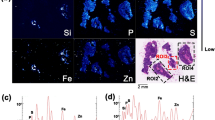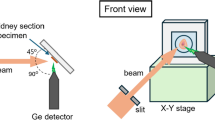Abstract
This study aims at evaluating the capabilities of synchrotron radiation micro X-ray fluorescence spectrometry (SR micro-XRF) for qualitative and semi-quantitative elemental mapping of the distribution of actinides in human tissues originating from individuals with documented occupational exposure. The investigated lymph node tissues were provided by the United States Transuranium and Uranium Registries (USTUR) and were analyzed following appropriate sample pre-treatment. Semi-quantitative results were obtained via calibration by external standards and demonstrated that the uranium concentration level in the detected actinide hot spots reaches more than 100 μg/g. For the plutonium hot spots, concentration levels up to 31 μg/g were found. As illustrated by this case study on these unique samples, SR micro-XRF has a high potential for this type of elemental bio-imaging owing to its high sensitivity, high spatial resolution, and non-destructive character.
ᅟ

SR micro-XRF study of the distribution of actinitides in human tissues. Left Location of the U-contaminated tissue sample in the human body. Middle U distribution derived from the high resolution SR micro-XRF scan on the tissue sample, indication of five U hot spots. Right Detail of the point measurement spectrum of U hot spot 3, intense U-Lα fluorescence peak located at 13.6 keV.



Similar content being viewed by others
References
Kalmykov SN, Denecke MA (2011) Actinide nanoparticle research, DOI 10.1007/978-3-642-11432-8_12, Springer-Verlag Berlin Heidelberg, New York
Smith JT, Beresford NA (2005) Chernobyl—catastrophe and consequences. Springer-Verlag Berlin Heidelberg, New York, ISBN 3-540-23866-2
United States Transuranium & Uranium Registries (USTUR). Washington State University College of Pharmacy. http://www.ustur.wsu.edu. Accessed 28 Oct 2014
Williams DB, Carter CB (1996) Transmission electron microscopy. A textbook for materials science. Springer, New York
Moore KT (2010) X-ray and electron microscopy of actinide materials. Micron 41:336–358
Becker JS (2003) Mass spectrometry of long-lived radionuclides. Spectrochim Acta B At Spectrosc 58:1757–1784
Boye P, Feldkamp JM, Patommel J, Schwab A, Stephan S, Hoppe R, Schroer CG, Burghammer M, Riekel C, van der Hart A, Küchler M (2009) Nanofocusing refractive X-ray lenses: fabrication and modeling. J Phys Conf Ser 186:012063
Beckhoff B, Kanngiesser B, Langhoff N, Wedell R, Wolff H (2005) Handbook of practical X-ray fluorescence analysis. Springer Berlin Heidelberg, New York
Vincze L, Vekemans B, Brenker FE, Falkenberg F, Rickers K, Somogyi A, Kersten M, Adams F (2004) Three-dimensional trace element analysis by confocal X-ray microfluorescence imaging. Anal Chem 76:6786–6791
Kanngiesser B, Malzer W, Reiche I (2003) A new 3D micro X-ray fluorescence analysis set-up—first archaeometric applications. Nucl Instrum Methods Phys Res B 211:259–264
Pearson DG, Brenker FE, Nestola F, McNeill J, Nasdala L, Hutchison MT, Matveev S, Mather K, Silversmit G, Schmitz S, Vekemans B, Vincze L (2014) Hydrous mantle transition zone indicated by ringwoodite included within diamond. Nature 507:221–224
Rindby A, Janssens K, Osan J (2003) Reconstruction of the three-dimensional distribution of elements in fly-ash particles by micro-XRF spectroscopy. X-Ray Spectrom 32:248–257
Lind OC, Salbu B, Janssens K, Proost K, García-León M, García-Tenorio R (2007) Characterization of U/Pu particles originating from the nuclear weapon accidents at Palomares, Spain, 1966 and Thule, Greenland, 1968. Sci Total Environ 376:294–305
Lind OC, Salbu B, Skipperud L, Janssens K, Jaroszewicz J, De Nolf W (2009) Solid state speciation and potential bioavailability of depleted uranium particles from Kosovo and Kuwait. J Environ Radioact 100:301–307
Begg BD, Hess NJ, Weber WJ, Conradson SD, Schweiger MJ, Ewing RC (2000) XAS and XRD study of annealed 238Pu- and 239Pu-substituted zircons (Zr0.92Pu0.08SiO4). J Nuc Mat 278:212–224
Salbu B, Lind OC, Skipperud L (2004) Radionuclide speciation and its relevance in environmental impact assessments. J Environ Radioactivity 74:233–242
Conradson SD (2000) XAFS—a technique to probe local structure. Los Alamos Sci 26:422–435
Hare D, Tolmachev S, James A, Bishop D, Austin C, Fryer F, Doble P (2010) Elemental bio-imaging of thorium, uranium, and plutonium in tissues from occupationally exposed former nuclear workers. Anal Chem 82:3176–3182
Avtandilashvili M, Brey R, James AC (2012) Maximum likelihood analysis of bioassay data from long-term follow-up of two refractory PuO2 inhalation cases. Health Phys 103:70–79
Vekemans B, Janssens K, Vincze L, Adams F, Van Espen P (1994) Analysis of X-ray spectra by iterative least squares (AXIL): new developments. X-Ray Spectrom 23:278–285
Interactive Data Language, Exelis Visual Information Solutions, Boulder, Colorado. http://www.exelisvis.com. Accessed 28 Oct 2014
Falkenberg G, Clauss O, Swiderski A, Tschentscher T (2001) Upgrade of the x-ray fluorescence beamline at HASYLAB/DESY. X-Ray Spectrom 30:170–173
Kolev NI (2009) Multiphase flow dynamics 4: nuclear thermal hydraulics. Springer-Verlag Berlin Heidelberg, New York, ISBN: 978-3-540-92917-8
Glazoff VM, Tokuhiro A, Rashkeev SN, Sabharwall P (2014) Oxidation and hydrogen uptake in zirconium, zircaloy-2 and zircaloy-4: computational thermodynamics and ab initio calculations. J Nuc Mat 444:65–75
Schoonjans T, Brunetti A, Golosio B, Sanchez del Rio M, Armando Solé V, Ferrero C, Vincze L (2011) The xraylib library for X-ray–matter interactions. Recent developments. Spectrochim Acta Part B 66:776–784
Laforce B, Schmitz S, Vekemans B, Rudloff J, Garrevoet J, Tucoulou R, Brenker FE, Martínez-Criado G, Vincze L (2014) Nanoscopic X-ray fluorescence imaging of meteoritic particles and diamond inclusions. Anal Chem 86:12369–12374
Casadio F, Rose V (2013) High-resolution fluorescence mapping of impurities in historical zinc oxide pigments: hard X-ray nanoprobe applications to the paints of Pablo Picasso. Appl Phys A 111:1–8
Brenker F et al (2014) Stardust interstellar preliminary examination V: XRF analyses of interstellar dust candidates at ESRF ID13. Meteorit Planet Sci 49:1594–1611
Giesen C, Wang HAO, Schapiro D, Zivanovic N, Jacobs A, Hattendorf B, Schüffler PJ, Grolimund D, Buhmann JM, Brandt S, Varga Z, Wild PJ, Günther D, Bodenmiller B (2014) Highly multiplexed imaging of tumor tissues with subcellular resolution by mass cytometry. Nat Methods 11:417–422
Van Malderen SJM, van Elteren JT, Vanhaecke F (2015) Development of a fast laser ablation-inductively coupled plasma-mass spectrometry cell for sub-mm scanning of layered materials. J Anal At Spectrom 30:119–125
Acknowledgments
The authors wish to thank the USTUR for providing the samples that were investigated in this study. The USTUR is funded by US Department of Energy, Office of Domestic and International Studies (AU-13), under grant award no. DE-HS0000073. Part of this research were carried out at the light source DORIS at DESY, a member of the Helmholtz Association (HGF) and the authors wish to thank DESY-Photon Science for granting this beamlime. Eva Vergucht acknowledges the Flemish Institute for the Promotion of Scientific and Technological Research in Industry (IWT, Flanders, Belgium) for her doctoral grant. Dr. Andrei Izmer and Dr. Björn De Samber acknowledge the Research Foundation Flanders (FWO, Flanders, Belgium) for their postdoctoral grants. The SR micro-XRF measurements were partially supported by the European Community’s Seventh Framework Programme (FP7/2007–2013) under grant agreement no. 312284. The authors also thank Leen Pieters for taking care of the sample preparation and Fanny Claverie (National Institute of Standards and Technology, NIST) for providing the standard reference material.
Author information
Authors and Affiliations
Corresponding author
Electronic supplementary material
Below is the link to the electronic supplementary material.
ESM 1
(PDF 3457 kb)
Rights and permissions
About this article
Cite this article
Vergucht, E., De Samber, B., Izmer, A. et al. Study of the distribution of actinides in human tissues using synchrotron radiation micro X-ray fluorescence spectrometry. Anal Bioanal Chem 407, 1559–1566 (2015). https://doi.org/10.1007/s00216-014-8421-4
Received:
Revised:
Accepted:
Published:
Issue Date:
DOI: https://doi.org/10.1007/s00216-014-8421-4




